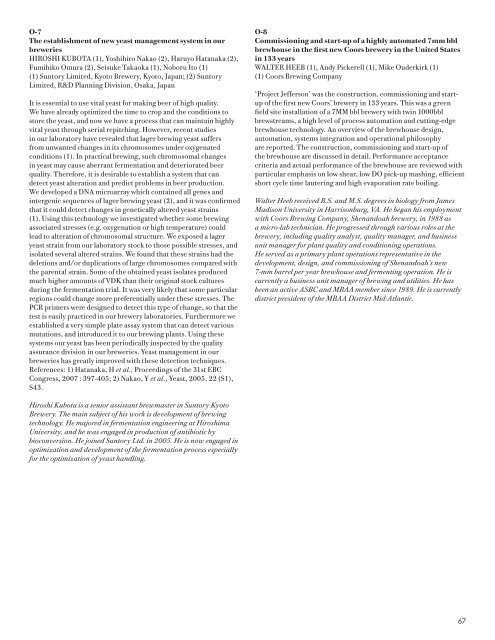Program Book - Master Brewers Association of the Americas
Program Book - Master Brewers Association of the Americas
Program Book - Master Brewers Association of the Americas
Create successful ePaper yourself
Turn your PDF publications into a flip-book with our unique Google optimized e-Paper software.
O-7<br />
The establishment <strong>of</strong> new yeast management system in our<br />
breweries<br />
HIROSHI KUBOTA (1), Yoshihiro Nakao (2), Haruyo Hatanaka (2),<br />
Fumihiko Omura (2), Seisuke Takaoka (1), Noboru Ito (1)<br />
(1) Suntory Limited, Kyoto Brewery, Kyoto, Japan; (2) Suntory<br />
Limited, R&D Planning Division, Osaka, Japan<br />
It is essential to use vital yeast for making beer <strong>of</strong> high quality.<br />
We have already optimized <strong>the</strong> time to crop and <strong>the</strong> conditions to<br />
store <strong>the</strong> yeast, and now we have a process that can maintain highly<br />
vital yeast through serial repitching. However, recent studies<br />
in our laboratory have revealed that lager brewing yeast suffers<br />
from unwanted changes in its chromosomes under oxygenated<br />
conditions (1). In practical brewing, such chromosomal changes<br />
in yeast may cause aberrant fermentation and deteriorated beer<br />
quality. Therefore, it is desirable to establish a system that can<br />
detect yeast alteration and predict problems in beer production.<br />
We developed a DNA microarray which contained all genes and<br />
intergenic sequences <strong>of</strong> lager brewing yeast (2), and it was confirmed<br />
that it could detect changes in genetically altered yeast strains<br />
(1). Using this technology we investigated whe<strong>the</strong>r some brewing<br />
associated stresses (e.g. oxygenation or high temperature) could<br />
lead to alteration <strong>of</strong> chromosomal structure. We exposed a lager<br />
yeast strain from our laboratory stock to those possible stresses, and<br />
isolated several altered strains. We found that <strong>the</strong>se strains had <strong>the</strong><br />
deletions and/or duplications <strong>of</strong> large chromosomes compared with<br />
<strong>the</strong> parental strain. Some <strong>of</strong> <strong>the</strong> obtained yeast isolates produced<br />
much higher amounts <strong>of</strong> VDK than <strong>the</strong>ir original stock cultures<br />
during <strong>the</strong> fermentation trial. It was very likely that some particular<br />
regions could change more preferentially under <strong>the</strong>se stresses. The<br />
PCR primers were designed to detect this type <strong>of</strong> change, so that <strong>the</strong><br />
test is easily practiced in our brewery laboratories. Fur<strong>the</strong>rmore we<br />
established a very simple plate assay system that can detect various<br />
mutations, and introduced it to our brewing plants. Using <strong>the</strong>se<br />
systems our yeast has been periodically inspected by <strong>the</strong> quality<br />
assurance division in our breweries. Yeast management in our<br />
breweries has greatly improved with <strong>the</strong>se detection techniques.<br />
References: 1) Hatanaka, H et al., Proceedings <strong>of</strong> <strong>the</strong> 31st EBC<br />
Congress, 2007 : 397-405; 2) Nakao, Y et al., Yeast, 2005, 22 (S1),<br />
S43.<br />
Hiroshi Kubota is a senior assistant brewmaster in Suntory Kyoto<br />
Brewery. The main subject <strong>of</strong> his work is development <strong>of</strong> brewing<br />
technology. He majored in fermentation engineering at Hiroshima<br />
University, and he was engaged in production <strong>of</strong> antibiotic by<br />
bioconversion. He joined Suntory Ltd. in 2005. He is now engaged in<br />
optimization and development <strong>of</strong> <strong>the</strong> fermentation process especially<br />
for <strong>the</strong> optimization <strong>of</strong> yeast handling.<br />
O-8<br />
Commissioning and start-up <strong>of</strong> a highly automated 7mm bbl<br />
brewhouse in <strong>the</strong> first new Coors brewery in <strong>the</strong> United States<br />
in 133 years<br />
WALTER HEEB (1), Andy Pickerell (1), Mike Ouderkirk (1)<br />
(1) Coors Brewing Company<br />
‘Project Jefferson’ was <strong>the</strong> construction, commissioning and startup<br />
<strong>of</strong> <strong>the</strong> first new Coors’ brewery in 133 years. This was a green<br />
field site installation <strong>of</strong> a 7MM bbl brewery with twin 1000bbl<br />
brewstreams, a high level <strong>of</strong> process automation and cutting-edge<br />
brewhouse technology. An overview <strong>of</strong> <strong>the</strong> brewhouse design,<br />
automation, systems integration and operational philosophy<br />
are reported. The construction, commissioning and start-up <strong>of</strong><br />
<strong>the</strong> brewhouse are discussed in detail. Performance acceptance<br />
criteria and actual performance <strong>of</strong> <strong>the</strong> brewhouse are reviewed with<br />
particular emphasis on low shear, low DO pick-up mashing, efficient<br />
short cycle time lautering and high evaporation rate boiling.<br />
Walter Heeb received B.S. and M.S. degrees in biology from James<br />
Madison University in Harrisonburg, VA. He began his employment<br />
with Coors Brewing Company, Shenandoah brewery, in 1988 as<br />
a micro-lab technician. He progressed through various roles at <strong>the</strong><br />
brewery, including quality analyst, quality manager, and business<br />
unit manager for plant quality and conditioning operations.<br />
He served as a primary plant operations representative in <strong>the</strong><br />
development, design, and commissioning <strong>of</strong> Shenandoah’s new<br />
7-mm barrel per year brewhouse and fermenting operation. He is<br />
currently a business unit manager <strong>of</strong> brewing and utilities. He has<br />
been an active ASBC and MBAA member since 1989. He is currently<br />
district president <strong>of</strong> <strong>the</strong> MBAA District Mid-Atlantic.<br />
67



